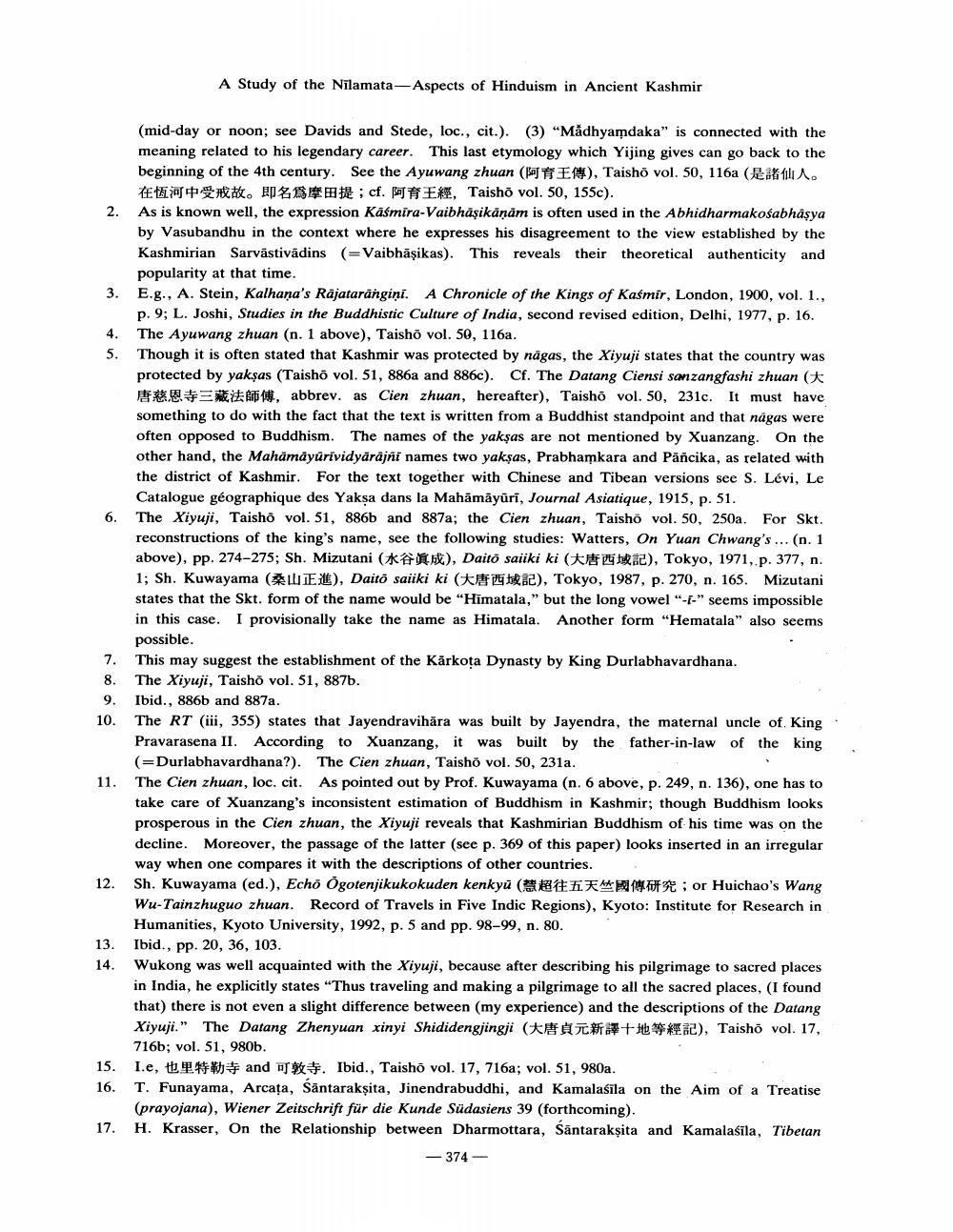Book Title: Remarks On Religious Predominance In Kashmir Hindu Or Buddhist Author(s): Toru Funayama Publisher: Toru Funayama View full book textPage 8
________________ (mid-day or noon; see Davids and Stede, loc., cit.). (3) "Madhyamdaka" is connected with the meaning related to his legendary career. This last etymology which Yijing gives can go back to the beginning of the 4th century. See the Ayuwang zhuan (BE), Taisho vol. 50, 116a ( Z; cf. E, Taisho vol. 50, 155c). . 2. As is known well, the expression Kāśmira-Vaibhāṣikāṇām is often used in the Abhidharmakośabhāṣya by Vasubandhu in the context where he expresses his disagreement to the view established by the Kashmirian Sarvästivādins (=Vaibhāṣikas). This reveals their theoretical authenticity and popularity at that time. 3. E.g., A. Stein, Kalhaṇa's Rājatarāngiṇī. A Chronicle of the Kings of Kasmir, London, 1900, vol. 1., p. 9; L. Joshi, Studies in the Buddhistic Culture of India, second revised edition, Delhi, 1977, p. 16. The Ayuwang zhuan (n. 1 above), Taishō vol. 50, 116a. Though it is often stated that Kashmir was protected by nagas, the Xiyuji states that the country was protected by yaksas (Taisho vol. 51, 886a and 886c). Cf. The Datang Ciensi sanzangfashi zhuan ( *=*, abbrev. as Cien zhuan, hereafter), Taishō vol. 50, 231c. It must have something to do with the fact that the text is written from a Buddhist standpoint and that nāgas were often opposed to Buddhism. The names of the yakṣas are not mentioned by Xuanzang. On the other hand, the Mahāmāyürividyārājni names two yakṣas, Prabhamkara and Pāñcika, as related with the district of Kashmir. For the text together with Chinese and Tibean versions see S. Lévi, Le Catalogue géographique des Yakṣa dans la Mahāmāyūrī, Journal Asiatique, 1915, p. 51. 6. The Xiyuji, Taisho vol. 51, 886b and 887a; the Cien zhuan, Taishō vol. 50, 250a. For Skt. reconstructions of the king's name, see the following studies: Watters, On Yuan Chwang's... (n. 1 above), pp. 274-275; Sh. Mizutani (*), Daito saiiki ki (2), Tokyo, 1971, p. 377, n. 1; Sh. Kuwayama (LE), Daitō saiki ki (2), Tokyo, 1987, p. 270, n. 165. Mizutani states that the Skt. form of the name would be "Himatala," but the long vowel "--" seems impossible in this case. I provisionally take the name as Himatala. Another form "Hematala" also seems possible. 4. 5. A Study of the Nilamata-Aspects of Hinduism in Ancient Kashmir 7. This may suggest the establishment of the Karkota Dynasty by King Durlabhavardhana. 8. The Xiyuji, Taisho vol. 51, 887b. 9. Ibid., 886b and 887a. 10. The RT (iii, 355) states that Jayendravihara was built by Jayendra, the maternal uncle of. King Pravarasena II. According to Xuanzang, it was built by the father-in-law of the king (=Durlabhavardhana?). The Cien zhuan, Taisho vol. 50, 231a. 11. The Cien zhuan, loc. cit. As pointed out by Prof. Kuwayama (n. 6 above, p. 249, n. 136), one has to take care of Xuanzang's inconsistent estimation of Buddhism in Kashmir; though Buddhism looks prosperous in the Cien zhuan, the Xiyuji reveals that Kashmirian Buddhism of his time was on the decline. Moreover, the passage of the latter (see p. 369 of this paper) looks inserted in an irregular way when one compares it with the descriptions of other countries. 12. Sh. Kuwayama (ed.), Echō Ōgotenjikukokuden kenkyu (; or Huichao's Wang Wu-Tainzhuguo zhuan. Record of Travels in Five Indic Regions), Kyoto: Institute for Research in Humanities, Kyoto University, 1992, p. 5 and pp. 98-99, n. 80. 13. Ibid., pp. 20, 36, 103. 14. Wukong was well acquainted with the Xiyuji, because after describing his pilgrimage to sacred places in India, he explicitly states "Thus traveling and making a pilgrimage to all the sacred places, (I found that) there is not even a slight difference between (my experience) and the descriptions of the Datang Xiyuji." The Datang Zhenyuan xinyi Shididengjingji (+), Taishō vol. 17, 716b; vol. 51, 980b. 15. 16. 17. I.e, and J. Ibid., Taisho vol. 17, 716a; vol. 51, 980a. T. Funayama, Arcata, Śantarakṣita, Jinendrabuddhi, and Kamalaśīla on the Aim of a Treatise (prayojana), Wiener Zeitschrift für die Kunde Südasiens 39 (forthcoming). H. Krasser, On the Relationship between Dharmottara, Śantarakṣita and Kamalasila, Tibetan -374Page Navigation
1 ... 6 7 8 9
